The NVIDIA GeForce GTX 1080 Ti Founder's Edition Review: Bigger Pascal for Better Performance
by Ryan Smith on March 9, 2017 9:00 AM EST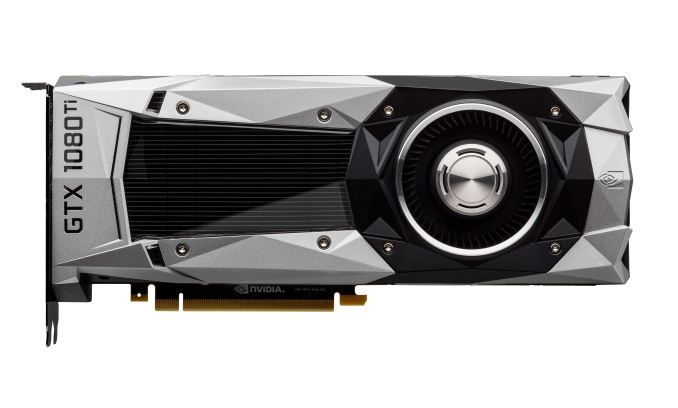
2016 will go down in history as the year where everything went NVIDIA’s way. Last year ended up being a banner year for the company, with NVIDIA’s revenue and profits growing by leaps and bounds to set some very big records. And that outcome is not a fluke; from automotive to datacenter to consumer graphics cards, the company was able to execute almost perfectly, delivering solid products built around their 16nm Pascal architecture.
But why do I bring this up in a video card review? In part because NVIDIA needs to follow up what was their greatest year ever, and in part because if it feels like NVIDIA is taking a bit of a victory lap, you wouldn’t be wrong. When NVIDIA launched the GeForce GTX 1080 back in May they set a new high bar for GPU performance, and they never once had to look back. Consequently the last 10 months have been witness to the NVIDIA’s greatest flagship-level performance lead in at least a decade; the high-end video card market and its lucrative profits have belonged to NVIDIA and NVIDIA alone.
However that was 2016. We’re now 3 months into 2017 and approaching Pascal’s first birthday, and NVIDIA needs to set the stage for the next year to come. If NVIDIA wants to repeat 2016 then they need to refresh their product lineup to deliver better performance and a better value, to capture the still-significant portion of the PC gaming market still on 28nm-generation architectures like Maxwell, Kepler, and GCN 1.x. And, as the saying goes, there’s no better place to start at than the top.
Unveiled last week at GDC and launching tomorrow is the GeForce GTX 1080 Ti. Based on NVIDIA’s GP102 GPU – aka Bigger Pascal – the job of GTX 1080 Ti is to serve as a mid-cycle refresh of the GeForce 10 series. Like the GTX 980 Ti and GTX 780 Ti before it, that means taking advantage of improved manufacturing yields and reduced costs to push out a bigger, more powerful GPU to drive this year’s flagship video card. And, for NVIDIA and their well-executed dominance of the high-end video card market, it’s a chance to run up the score even more.
| NVIDIA GPU Specification Comparison | ||||||
| GTX 1080 Ti | NVIDIA Titan X | GTX 1080 | GTX 980 Ti | |||
| CUDA Cores | 3584 | 3584 | 2560 | 2816 | ||
| Texture Units | 224 | 224 | 160 | 176 | ||
| ROPs | 88 | 96 | 64 | 96 | ||
| Core Clock | 1481MHz | 1417MHz | 1607MHz | 1000MHz | ||
| Boost Clock | 1582MHz | 1531MHz | 1733MHz | 1075MHz | ||
| TFLOPs (FMA) | 11.3 TFLOPs | 11 TFLOPs | 9 TFLOPs | 6.1 TFLOPs | ||
| Memory Clock | 11Gbps GDDR5X | 10Gbps GDDR5X | 10Gbps GDDR5X | 7Gbps GDDR5 | ||
| Memory Bus Width | 352-bit | 384-bit | 256-bit | 384-bit | ||
| VRAM | 11GB | 12GB | 8GB | 6GB | ||
| FP64 | 1/32 | 1/32 | 1/32 | 1/32 | ||
| FP16 (Native) | 1/64 | 1/64 | 1/64 | N/A | ||
| INT8 | 4:1 | 4:1 | N/A | N/A | ||
| TDP | 250W | 250W | 180W | 250W | ||
| GPU | GP102 | GP102 | GP104 | GM200 | ||
| Transistor Count | 12B | 12B | 7.2B | 8B | ||
| Die Size | 471mm2 | 471mm2 | 314mm2 | 601mm2 | ||
| Manufacturing Process | TSMC 16nm | TSMC 16nm | TSMC 16nm | TSMC 28nm | ||
| Launch Date | 03/10/2017 | 08/02/2016 | 05/27/2016 | 06/01/2015 | ||
| Launch Price | $699 | $1200 | MSRP: $599 Founders $699 |
$649 | ||
With the GTX 1080 Ti, NVIDIA is aiming for what they’re calling their greatest performance jump yet for a modern Ti product – around 35% on average. This would translate into a sizable upgrade for GeForce GTX 980 Ti owners and others for whom GTX 1080 wasn’t the card they were looking for.
We’ll start as always with the GPU at the heart of the card, GP102. With NVIDIA’s business now supporting a dedicated compute GPU – the immense GP100 – GP102 doesn’t qualify for the “Big Pascal” moniker like past iterations have. But make no mistake, GP102 is quite a bit larger than the GP104 GPU at the heart of the GTX 1080, and that translates to a lot more hardware for pushing pixels.
GTX 1080 Ti ships with 28 of GP102’s 30 SMs enabled. For those of you familiar with the not-quite-consumer NVIDIA Titan X (Pascal), this is the same configuration as that card, and in fact there are a lot of similarities between those two cards. Though for this generation the situation is not going to be cut & dry as in the past; the GTX 1080 Ti is not strictly a subset of the Titan.
The big difference on the hardware front is that NVIDIA has stripped GP102 of some of its memory/ROP/L2 capacity, which was fully enabled on the Titan. Of the 96 ROPs we get 88; the last ROP block, its memory controller, and 256KB of L2 cache have been disabled. Otherwise, relative to the current top dog on the GeForce side, GTX 1080, we’re looking at a nearly 40% increase in the number of functional units, which will put the GTX 1080 Ti in its own class.
In terms of clockspeeds the GTX 1080 Ti ships with a 1.48GHz base clock and a 1.58GHz boost clock. This is a bit lower than the clocks the GTX 1080 shipped at – 1.6GHz and 1.73GHz respectively – though par for the course for video cards based on these bigger GPUs. Though more importantly, as we’ve seen time and time again with Maxwell and Pascal, the complex nature of NVIDIA’s turbo mechanism means that the average clockspeeds of an NVIIDA card are frequently higher than NVIDIA’s official values, and that means that GTX 1080 Ti is defined more by its performance in the field than its specifications on paper.
Meanwhile on the memory front, the GTX 1080 Ti is the first card NVIDIA is equipping with partner Micron’s second-generation GDDR5X memory. This refined design allows for higher clockspeeds, allowing NVIDIA to ship the GTX 1080 Ti with an 11Gbps memory clock, a 10% increase over the 10Gbps clock found on the Titan and the GTX 1080. This memory is situated on a cut-down 352-bit memory bus – NVIDIA has disabled the last 32-bit channel in part to differentiate the card from Titan X – which works out to 11GB of memory with a total bandwidth of 484GB/sec for the GTX 1080 Ti.
Going by the numbers then, the GTX 1080 Ti offers just over 11.3 TFLOPS of FP32 performance. This puts the expected shader/texture performance of the card 28% ahead of the current GTX 1080, while the ROP throughput advantage stands 26%, and memory bandwidth at a much greater 51.2%. Real-world performance will of course be influenced by a blend of these factors, with memory bandwidth being the real wildcard. Otherwise, relative to the NVIDIA Titan X, the two cards should end up quite close, trading blows now and then.
Speaking of the Titan, on an interesting side note, NVIDIA isn’t going to be doing anything to hurt the compute performance of the GTX 1080 Ti to differentiate the card from the Titan, which has proven popular with GPU compute customers. Crucially, this means that the GTX 1080 Ti gets the same 4:1 INT8 performance ratio of the Titan, which is critical to the cards’ high neural networking inference performance. As a result the GTX 1080 Ti actually has slightly greater compute performance (on paper) than the Titan. And NVIDIA has been surprisingly candid in admitting that unless compute customers need the last 1GB of VRAM offered by the Titan, they’re likely going to buy the GTX 1080 Ti instead.
Moving on, the card’s 250W TDP should not come as a surprise. This has been NVIDIA’s segment TDP of choice for Titan and Ti cards for a while now, and the GTX 1080 Ti isn’t deviating from that. GTX 1080 Ti isn’t necessarily meant to be more efficient than GTX 1080 – we’re still looking at the same architecture on the same manufacturing node – but instead it’s a more powerful GeForce for those users who are willing to trade power consumption for improved performance.
With the specs out of the way, let’s talk about market positioning, pricing, and availability. Like the GTX 1080 before it, NVIDIA is once again going to be working with partners to offer a mix of reference and custom designs. The GTX 1080 Ti will initially be offered in a Founder’s Edition design, while partners are also bringing up their own semi and fully custom designs to be released in April. Importantly however, unlike the GTX 1080 & GTX 1070, NVIDIA has done away with the Founder’s Edition premium for the GTX 1080 Ti. The MSRP of the card will be the MSRP for both the Founder’s Edition and partners’ custom cards. This makes pricing more consistent, though I’m curious to see how this plays out with partners, as they benefitted from the premium in the form of more attractive pricing for their own cards.
As for pricing, with the launch of the GeForce GTX 1080 Ti, NVIDIA and their partners are shuffling their product stacks to accommodate the new card. The GTX 1080 Ti is being priced at $699, which was the original launch price for the GeForce GTX 1080 Founder’s Edition. The GTX 1080 has in turn received a price cut, with the base cards going down to $499, and the Founder’s Edition going down to $549. For better or worse this $699 price tag does work out to being a bit of a price hike over the GeForce GTX 980 Ti – it launched at $649 two years ago – but at the same time it's still more aggressive than I had been expecting given the GTX 1080's launch price last year.
The GTX 1080 Ti will be launching tomorrow, with today’s review embargo designed to whet your appetite (and perhaps open up your wallet). NVIDIA and their partners will be selling the Founder’s Edition cards for the launch, so while it’s likely that the first shipment will sell out, everyone should have their usual choice of tier 1 retailers. Meanwhile in a bit of news that didn’t get disclosed at GDC, NVIDIA is including the GTX 1080 Ti in their latest Prepare for Battle game bundle, an unexpected move given that NVIDIA has shied away from launch bundles on high-end cards in recent years. Under NVIDIA’s latest bundle program, buyers will qualify for a free copy of either Ubisoft’s For Honor or Tom Clancy’s Ghost Recon Wildlands, both of which have launched in the last few weeks.
Finally, looking at the competitive landscape, there’s not much to say right now. GTX 1080 Ti is NVIDIA’s chance to run up the score even further, giving them a solid 1-2-3 position in the market. GTX 1080 Ti will eventually have to do battle with AMD’s RX Vega video cards sometime in the next quarter, but as that’s still months off and Vega is an unknown in terms of performance, it’s not a factor at this time. For GTX 980 Ti and GTX 780 Ti owners, this is the card NVIDIA would like to sell you as your next upgrade. And if you managed to hold off on buying a GTX 1080 FE last year, then the GTX 1080 Ti is going to bring a lot more performance for the same price.
| Spring 2017 GPU Pricing Comparison | |||||
| AMD | Price | NVIDIA | |||
| $699 | GeForce GTX 1080 Ti | ||||
| $499 | GeForce GTX 1080 | ||||
| $399 | GeForce GTX 1070 | ||||
| $249 | GeForce GTX 1060 (6GB) | ||||
| Radeon RX 480 (8GB) | $209 | ||||


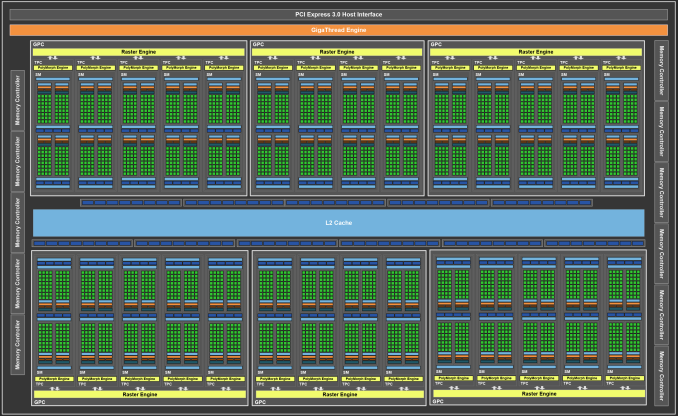
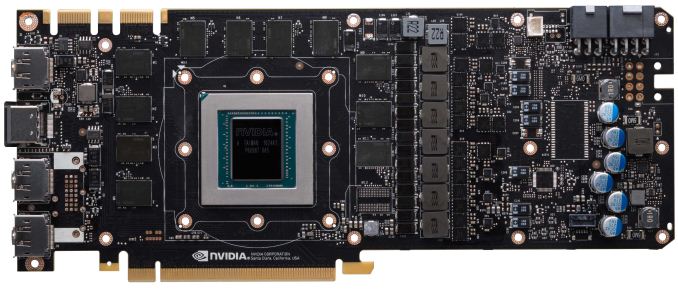
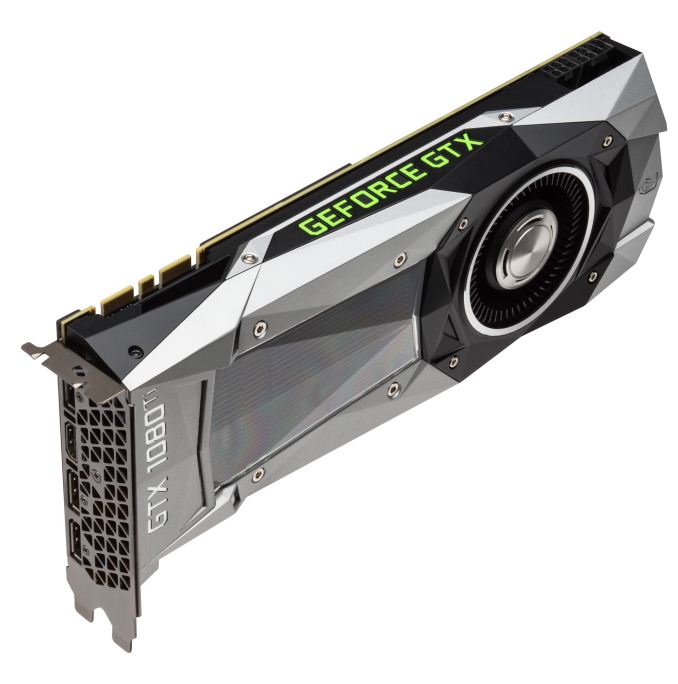
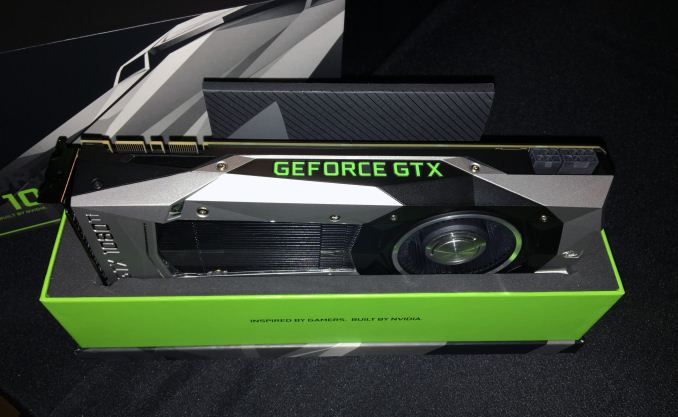








161 Comments
View All Comments
eddman - Friday, March 10, 2017 - link
So we moved from "nvidia pays devs to deliberately not optimize for AMD" to "nvidia works with devs to optimize the games for their own hardware, which might spoil them and result in them not optimizing for AMD properly".How is that bribery, illegal? If they did not prevent the devs from optimizing for AMD then nothing illegal happened. It was the devs own doing.
ddriver - Friday, March 10, 2017 - link
Nope, there is an implicit, unspoken condition to receiving support from nvidia. To lazy slobs, that's welcome, and most devs are lazy slobs. Their line of reasoning is quite simple:"Working to optimize for amd is hard, I am a lazy and possibly lousy developer, so if they don't do that for me like nvidia does, I won't do that either, besides that would angry nvidia, since they only assist me in order to make their hardware look better, if I do my job and optimize for amd and their hardware ends up beating nvidia's, I risk losing nvidia's support, since why would they put money into helping me if they don't get the upper hand in performance. Besides, most people use nvidia anyway, so why even bother. I'd rather be taken to watch strippers again than optimize my software."
Manipulation, bribery and extortion. nvidia uses its position to create situation in which game developers have a lot to profit from NOT optimizing for amd, and a lot to lose if they do. Much like intel did with its exclusive discounts. OEM's weren't exactly forced to take those discounts in exchange for not selling amd, they did what they knew would please intel to get rewarded for it. Literally the same thing nvidia does. Game developers know nvidia will be pleased to see their hardware getting an unfair performance advantage, and they know amd doesn't have the money to pamper them, so they do what is necessary please nvidia and ensure they keep getting support.
akdj - Monday, March 13, 2017 - link
Where to start?Best not to start, as you are completely, 100% insane and I've spent two and a half 'reads' of your replies... trying to grasp WTH you're talking about and I'm lost
Totally, completely lost in your conspiracy theories about two major GPU silicon builders while being apparently and completely clueless about ANY of it!
Lol - Wow, I'm truly astounded that you were able to make up that much BS ...
cocochanel - Friday, March 10, 2017 - link
You forgot to mention one thing. Nvidia tweaking the drivers to force users into hardware updates. Say, there is a bunch of games coming up this Christmas. If you have a card that's 3-4 years old, they release a new driver which performs poorly on your card ( on those games ) and another driver which performs way better on the newest cards. Then, if you start crying, they say: It's an old card, pal, why don't you buy a new one !With DX11 they could do that a lot. With DX12 and Vulkan it's a lot harder. Most if not all optimizations have to be done by the game programmers. Very little is left to the driver.
eddman - Friday, March 10, 2017 - link
That's how the ENTIRE industry is. Do you really expect developers to optimize for old architectures. Everyone does it, nvidia, AMD, intel, etc.It is not deliberate. Companies are not going to spend time and money on old hardware with little market share. That's how it's been forever.
Before you say that's not the case with radeons, it's because their GCN architecture hasn't changed dramatically since its first iteration. As a result, any optimization done for the latest GCN, affects the older ones to some extent too.
cocochanel - Friday, March 10, 2017 - link
There is good news for the future. As DX12 and Vulkan become mainstream API's, game developers will have to roll up their sleeves and sweat it hard. Architecturely, these API's are totally different from the ground up and both trace their origin from Mantle. And Mantle was the biggest advance in graphics API's in a generation. The good days for lazy game developers is coming to an end, since these new API's put just about everything back into their hands whether they like it or not. Tweaking the driver won't make much of a difference. Read the API's documentation.cmdrdredd - Monday, March 13, 2017 - link
Yes hopefully this will be the future where games are the responsibility of the developer. Just like on Consoles. I know people hate consoles sometimes but the closed platform shows which developers have their stuff together and which are lazy bums because Sony and Microsoft don't optimize anything for the games.Nfarce - Friday, March 10, 2017 - link
Always amusing watching to tin foil hat Nvidia conspiracy nuts talk. Here's my example: working on Project Cars as an "early investor." Slightly Mad Studios gave both Nvidia and AMD each 12 copies of the beta release to work on, the same copy I bought. Nvidia was in constant communication with SMS developers and AMD was all but never heard from. After about six months, Nvidia had a demo of the racing game ready for a promotion of their hardware. Since AMD didn't take Project Cars seriously with SMS, Nvidia was able to get the game tweaked better for Nvidia. And SMS hat-tipped Nvidia with having billboards in the game showing Nvidia logos.Of course all the AMD fanboys claimed unfair competition and the usual whining when their GPUs do not perform as well in some games as Nvidia (they amazingly stayed silent when DiRT Rally, another development I was involved with, ran better on AMD GPUs and had AMD billboards).
ddriver - Friday, March 10, 2017 - link
So was there anything preventing the actual developers from optimizing the game? They didn't have nvidia and amd hardware, so they sent betas to the companies to profile things and see how it runs?How silly one must be to expect that nvidia - a company that rakes in billions every year, and amd - a company is in the red most of the time and has lost billions, will have the same capacity to do game developers jobs for them?
It is the game developer's job top optimize. Alas, as it seems, nvidia has bred a new breed of developers - those who do their job half-assedly and then wait on them to optimize, conveniently creating unfair advantage to their hardware.
ddriver - Friday, March 10, 2017 - link
Also talking about fanboys - I am not that. Yes, I am running dozens of amd gpus, and I don't see myself buying any nvidia product any time soon, but that's only because the offer superior value to what I need them for.I don't give amd extra credit for offering a better value. I know this is not what they want. It is what they are being forced into.
I am in a way grateful to nvidia for sandbagging amd, because this way I can get a much better value products. If things were square between the two, and all games were equally optimized, then both companies would offer products with approximately identical value.
Which I would hate, because I'd lose the currently, 2-3x better value for the money i get with amd. I benefit and profit from nvidia being crooks, and I am happy that I can do that.
So nvidia, keep doing what you are doing. I am not really objecting, I am simply stating the facts. Of course, nvidia fanboys would have a problem understanding that, and a problem with anyone tarnishing the good name of that helpful awesome and paying for strippers company.